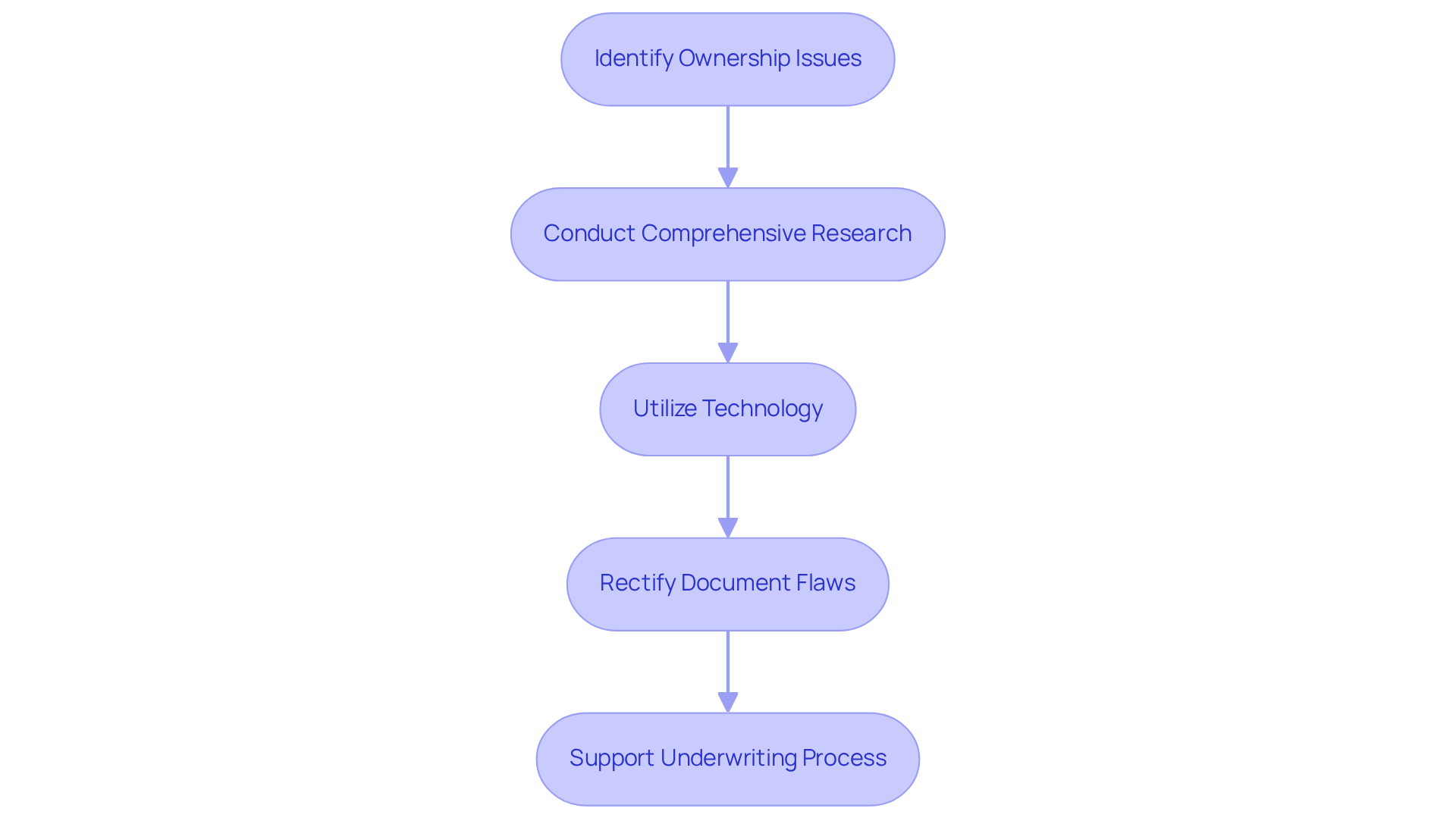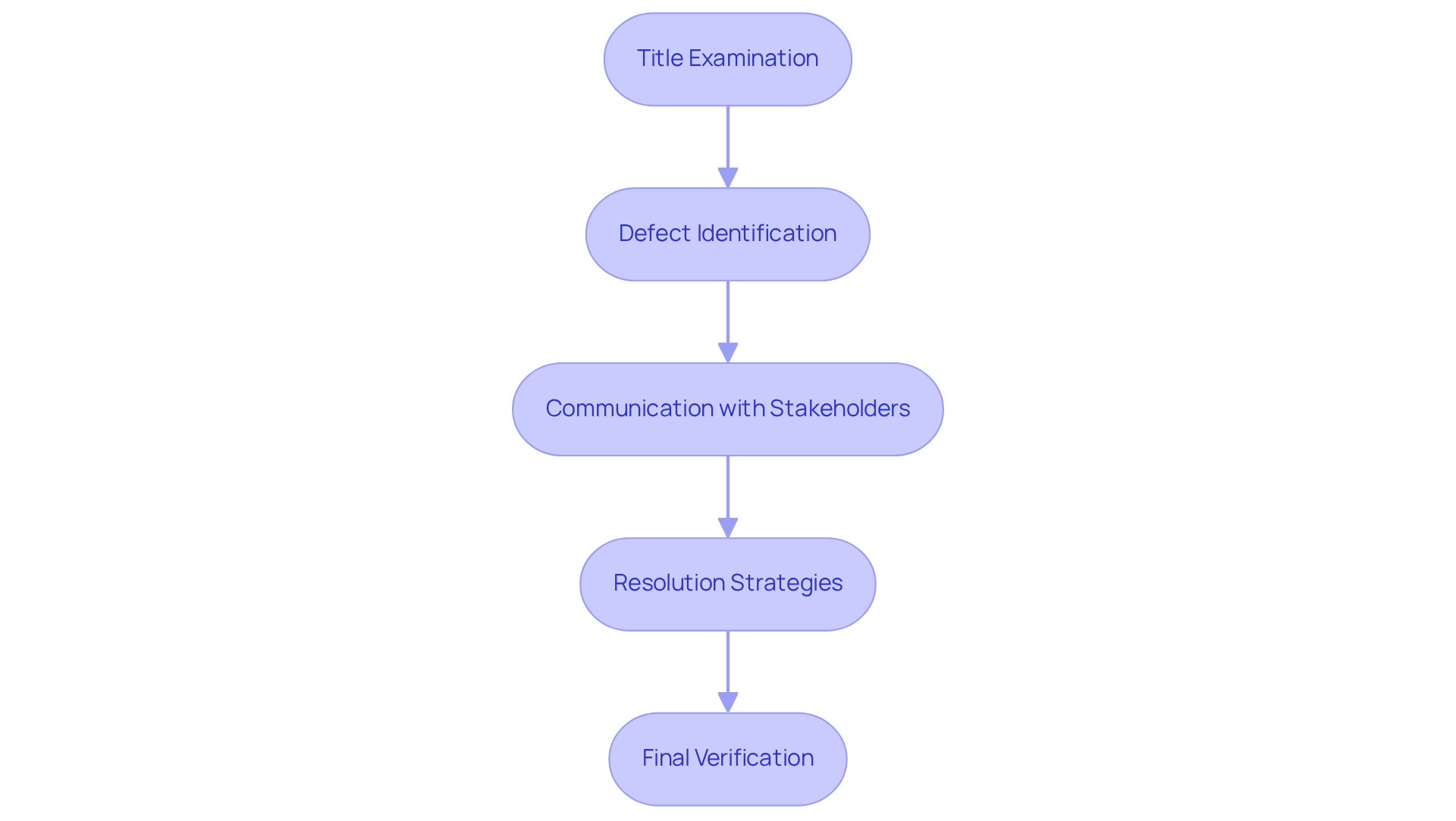Overview
Title curative services support underwriting by rectifying ownership document flaws and ensuring properties are free from encumbrances that could jeopardize ownership rights. These services play a crucial role in the real estate sector, as they facilitate smoother transactions and mitigate risks. Through rigorous research and advanced technologies, they ultimately reinforce the integrity of ownership records, expediting the underwriting process. Consequently, the implementation of these services not only enhances the reliability of real estate transactions but also instills confidence among stakeholders.
Introduction
Title curative services play a pivotal role in the real estate industry, ensuring that ownership documents are free from defects that could derail transactions. By addressing issues such as liens, errors in public records, and undisclosed heirs, these services not only protect the integrity of property ownership but also streamline the underwriting process. Furthermore, with the increasing complexity of real estate transactions and the prevalence of title defects, professionals must navigate these challenges effectively. Leveraging technology to enhance efficiency is essential in this evolving landscape.
Define Title Curative Services and Their Importance in Underwriting
Curative services for titles demonstrate how title curative supports underwriting by encompassing essential procedures and measures designed to rectify flaws or issues in ownership documents that may impede the underwriting of insurance policies. These services are vital, as they ensure properties are devoid of encumbrances, liens, or legal disputes that could threaten ownership rights. Harbinger Land employs a rigorous research methodology, involving comprehensive examination of public records, property surveys, and historical ownership documents. Our quality control protocols guarantee that every property search is meticulously reviewed for accuracy and completeness, empowering clients to confidently secure land rights and assets.
Proactively addressing these concerns not only facilitates but also safeguards the interests of all parties involved. For instance, a survey revealed that ownership complications were identified in 36% of residential property transactions in 2005, highlighting the prevalence of such issues and the necessity for thorough ownership research. Without effective curative services, defects can lead to significant delays or even transaction failures, illustrating how title curative supports underwriting in the process.
Furthermore, the integration of advanced technologies, including machine learning and optical character recognition, enhances the efficiency of these services, allowing for quicker resolution of ownership issues and ultimately expediting the closing process. This innovation is particularly crucial in a dynamic real estate market, where the volume of transactions correlates with an increase in ownership issues. By leveraging curative services, real estate professionals can mitigate risks and ensure clear ownership transfer, thereby reinforcing the integrity of ownership records.

Identify Common Title Defects and Challenges in Title Research
Common title defects include:
- Liens: Legal claims against an asset for unpaid debts, such as mortgages or tax liens. Approximately 25% of residential real estate transactions encounter challenges stemming from these liens, which can obstruct sales if not promptly addressed. Experts estimate that around 11 percent of closing issues are related to , underscoring the necessity of resolving these liens swiftly.
- Errors in Public Records: Mistakes in documentation, including misspelled names or inaccurate asset descriptions, can create confusion regarding ownership. While these errors may seem minor, they can lead to significant legal complications if left unaddressed. Most recording errors can be rectified by filing a corrective deed with the county recorder's office, providing a clear pathway to resolution.
- Undisclosed Heirs: Situations in which heirs are not accurately recognized can lead to potential claims against the property, complicating ownership and necessitating legal measures, such as a quiet title lawsuit.
- Fraud or Forgery: Instances of falsified documents can severely undermine the legitimacy of ownership, creating challenges for current proprietors and necessitating thorough investigations to uncover any fraudulent activity. The average insurance claim for fraud and forgery amounts to $143,000, highlighting the substantial financial ramifications of such issues.
- Boundary Disputes: Conflicts concerning property lines can complicate ownership claims and may require surveys or legal intervention for resolution. A new survey can clarify property boundaries, and if disputes persist, a quiet title action may be necessary to legally resolve ownership concerns.
Understanding these defects is crucial for researchers as they navigate the complexities of verification and ensure compliance with legal standards. The thriving real estate market in recent years has significantly increased the number of transactions, leading to the discovery of more ownership issues, making effective research more critical than ever.
Outline the Title Curative Process: Steps to Resolve Title Defects
is essential for ensuring clear property ownership and typically involves several key steps:
- Title Examination: A thorough assessment of the title history is performed to uncover any issues.
- Defect Identification: Specific issues uncovered during the examination are documented and categorized for clarity.
- Communication with Stakeholders: Engaging with relevant parties, such as previous owners, lienholders, or legal representatives, is crucial for gathering necessary information.
- Resolution Strategies: A customized plan is created to tackle each issue, which may involve negotiating lien releases, obtaining missing documents, or correcting public record errors.
- Final Verification: After addressing issues, a final review guarantees that the heading is clear and marketable.
This structured approach illustrates how title curative supports underwriting by streamlining the curative process and minimizing delays in closing transactions. Statistics indicate that most ownership defects can be resolved swiftly, frequently with only minor delays, emphasizing the significance of proactive examination strategies. Furthermore, engaging with experienced professionals can further enhance the effectiveness of these processes, ensuring that potential issues are addressed before they complicate sales.

Leverage Technology: How Automation Enhances Title Curative Services
Automation significantly enhances curative services by streamlining processes with advanced technologies such as machine learning and optical character recognition. These tools swiftly analyze extensive collections of document titles, identifying defects and discrepancies with greater efficiency than traditional manual methods. For instance, automated systems can pinpoint potential issues in real-time, enabling researchers to address them proactively—an essential practice for maintaining accuracy and compliance.
A notable case study is Parse AI, which employs machine learning to extract critical information from document titles, allowing researchers to finalize abstracts and reports more swiftly and precisely. This innovation not only reduces turnaround times but also lowers operational costs. In fact, 51% of IT leaders indicate that automation initiatives can decrease overall costs by 10% to 50%.
Furthermore, automation fosters improved communication and coordination among stakeholders, ensuring that all parties remain informed and engaged throughout the curative process. By leveraging these technological advancements, title companies can enhance service quality, which illustrates how title curative supports underwriting, ultimately benefiting and their clients.
Conclusion
Title curative services are indispensable in the realm of real estate, acting as a safeguard against ownership defects that could impede transactions. By rectifying issues such as liens, public record errors, and undisclosed heirs, these services not only uphold the integrity of property ownership but also facilitate a smoother underwriting process. The importance of these services cannot be overstated, particularly in an environment where the complexity of transactions and the prevalence of title defects continue to escalate.
Throughout the article, critical insights have been discussed, including:
- The common types of title defects that professionals encounter
- The structured process involved in resolving these issues
- The significant role of technology in enhancing curative services
The integration of automation and advanced technologies, such as machine learning, has proven to streamline the identification and resolution of title defects, ultimately leading to more efficient transactions. This proactive approach not only mitigates risks but also reinforces the reliability of ownership records.
In conclusion, the effective management of title curative services is crucial for real estate professionals aiming to navigate the complexities of property transactions successfully. Embracing technological advancements and understanding the key processes involved will empower stakeholders to address ownership issues promptly and efficiently. This proactive stance not only protects individual interests but also contributes to the overall health of the real estate market, ensuring that ownership transfers are clear and secure.
Frequently Asked Questions
What are title curative services?
Title curative services are procedures and measures designed to rectify flaws or issues in ownership documents that may impede the underwriting of insurance policies. They ensure properties are free from encumbrances, liens, or legal disputes that could threaten ownership rights.
Why are title curative services important in underwriting?
They are crucial as they help ensure clear ownership, mitigate risks, and facilitate smoother real estate transactions. Addressing ownership complications proactively safeguards the interests of all parties involved and prevents significant delays or transaction failures.
What methodology does Harbinger Land use for title curative services?
Harbinger Land employs a rigorous research methodology that includes comprehensive examination of public records, property surveys, and historical ownership documents, ensuring accuracy and completeness in property searches.
What was the significance of the survey mentioned in the article?
The survey revealed that ownership complications were identified in 36% of residential property transactions in 2005, highlighting the prevalence of such issues and the necessity for thorough ownership research.
How do advanced technologies enhance title curative services?
Technologies like machine learning and optical character recognition improve the efficiency of title curative services, allowing for quicker resolution of ownership issues and expediting the closing process in real estate transactions.
What are the benefits of leveraging curative services in real estate?
Leveraging curative services helps real estate professionals mitigate risks, ensure clear ownership transfer, and reinforce the integrity of ownership records, which is particularly important in a dynamic real estate market.




